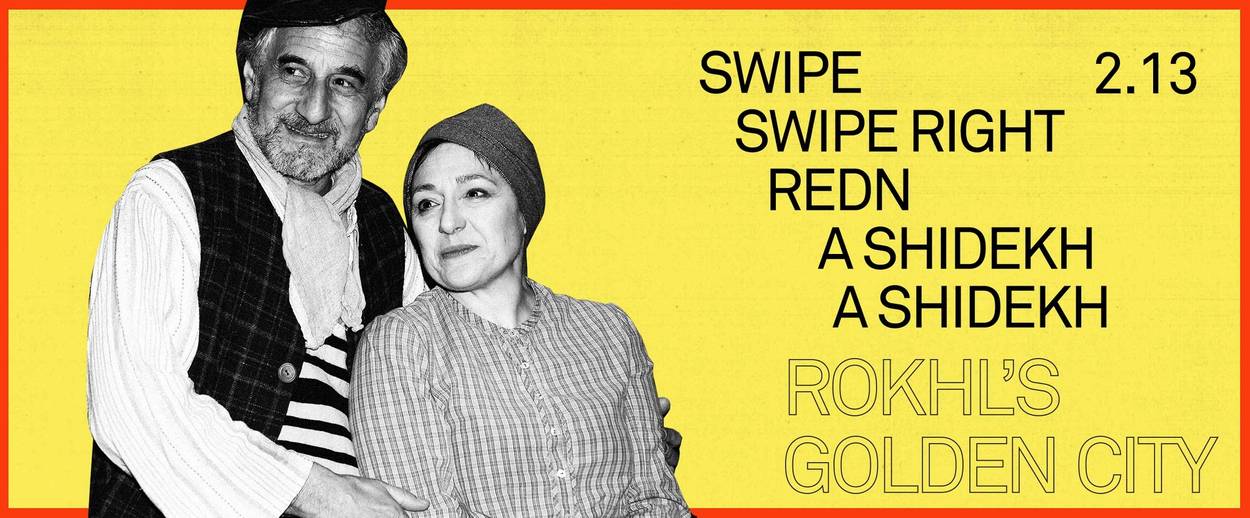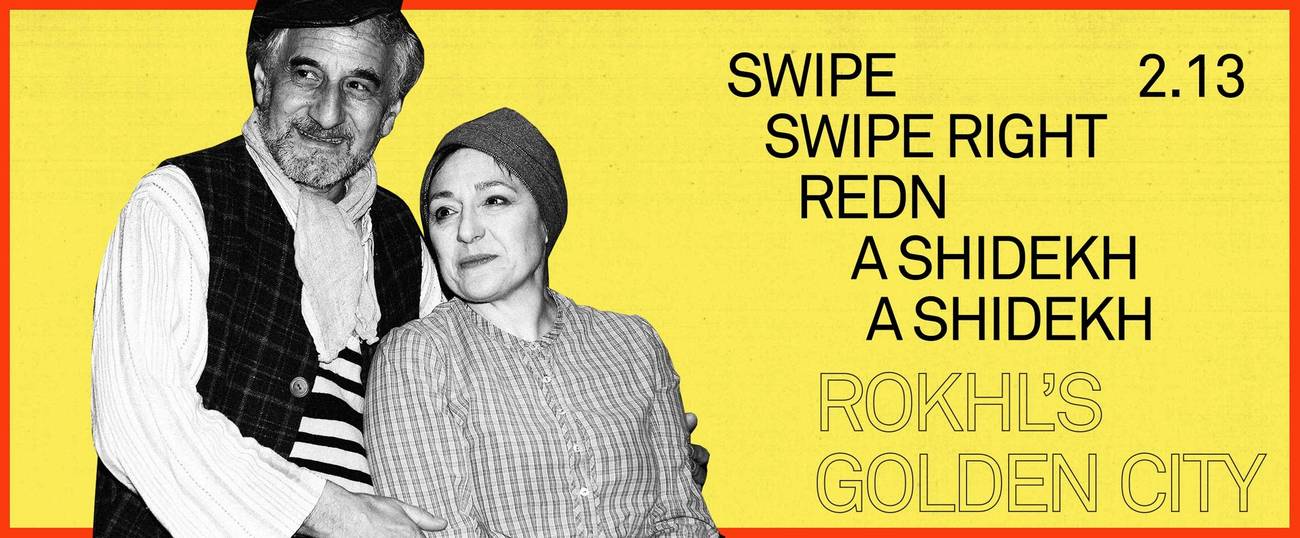My Yiddish Valentine
Rokhl’s Golden City: Love, lust, and ‘Fiddler on the Roof’




With apologies to Lenny Bruce.
Basketball is Jewish, skiing is goyish. Jell-O is goyish, pudding is Jewish. Lust is Jewish. Love, however, love is the ultimate in goyishe nakhes. Right?
Even the most disconnected, deracinated American Jew knows this to be true. After all, if love were a Yiddish value, would we have this timeless exchange?
As Michael Wex says in Born to Kvetch, “Like so much of Yiddish culture, marriage was more a matter of words than of anything else. It was a matter of conviction, of proof and persuasion, as opposed to desire.” What the shatkhn or matchmaker does is redn a shidekh, propose a match by way of conversation. And the people being persuaded weren’t the potential bride and groom, but their parents, the potential makhetonim. Though the law is clear that the bride and groom (especially the bride) may veto a match, the operative desires belong to the parents, not the kids. Romantic love isn’t in the picture.
Sex and lust were everywhere, of course. It just wasn’t a legitimate basis for matchmaking. If you’ve spent any time learning gemore, you know sex was a preoccupation of our Sages: how long it should take, how many times a week, and keynehore in what positions.
It’s no coincidence that I.L. Peretz, one of the three klasiker of modern Yiddish literature, entered the field of Yiddish letters in 1888 with a poem about lust and the modern bokher. “Monish” is the story of an ilui (Talmud prodigy) so pure and learned that Satan himself sends Lilith to seduce him. All the women of the town sigh over Monish, yet he only has eyes for Talmud. But even Monish cannot control himself when Lilith sets her sights on him. Lilith draws him to a ruin outside of town (a place classically associated with demons), where, in an explicitly erotic negotiation, she demands he pledge himself to her:
un er shvert ir baym poroykhes. baym poroykhes, bay der toyre!
(He swears by the curtain on the ark, by the Torah itself!)
un zi ruft alts hekher hekher
(and she calls out Higher Higher!)
Gevald.
It’s all been downhill since then, really. Since the Haskalah. And Tinder. We still think, this time, this time, I’m gonna swipe right on this guy and meet him in an old ruin and it will turn out all right. Maybe the old ruin is actually an escape room?
We think we’re smart enough to find our basherte/basherter (predestined partner) on our own, even though the whole idea of a bashert comes to us from the Talmud, which tells us that the bashert is assigned to us before we are even born. No free will necessary.
Though we know being fruitful and multiplying is the first mitsve, how many of us can truly say we’ve produced 2.1 children to replace ourselves? Or even tried? Traditional Judaism, as expressed through Yiddish, has a very low opinion of those of us who remain unmarried and childless, demographics aftselakhes (be damned).
Let’s imagine we’re in a New York where we all speak Yiddish but still recognize dina d’malkhuta dina, and the malkhut in this case is Hallmark Inc. We’d probably be sending each other snarky Valentine’s Day cards accusing/consoling each other for being an alte moyd (old maid) or alter bokher (old, unmarried manchild). If you wanted to be really snarky, you’d call someone a farzesene alte moyd, a spinster with the air of expired merchandise. The iker (core idea) here is that no matter how old you are, you’re not an adult, you don’t count until, and unless, you get married and reproduce. Who can wait for true love when the stakes are that high? How are you going to have even 2.1 daughters if you wait that long, let alone seven?
But before we get too caught up in comparing ourselves to fertile, but fictional, characters like Tevye and Golde, let’s take another look at the Anatevka we think we know. Almost immediately after Fiddler on the Roof appeared in 1964, professor Joseph Landis registered his displeasure with this new, extremely American Tevye. Among the many complaints in his classic essay “Fiddling With Sholem Aleichem,” he notes the way the show diminished the difference in emotional impact among Tseitel, Hodel, and Chava’s romantic choices.
For Landis, the show drastically overplayed Tevye’s reaction to Hodel and Tseitel choosing their own (Jewish) mates and underplayed the devastation of Chava’s choice of a non-Jewish husband. (He makes a really good point that the show conveniently leaves out Chava’s conversion, arguably the most gut-wrenching act of all):
It is Fiddler which asserts that tradition helped them maintain their balance—without really understanding that Jewish tradition had little to do with matchmakers or the maintenance of paternal authority or dancing between men and women. …Jewish tradition involved a religiously centered way of life with a clearly defined set of ethical and intellectual values.
Indeed, Landis notes, much later in the stories, in order to provide for the elderly and alone Tevye, his daughter Bielke “marries a vulgar war-profiteer named Padhatzur. When Tevye admonishes her for not following the dictates of her heart as Hodel did, Bielke reminds him that the world is not now what it once was: “Hodel lived in Hodel’s time; Bielke lives in Bielke’s time.”
So … maybe romantic love wasn’t quite as irrelevant as we think. It was just one part of an ever-changing equation. As a young man, Sholem Aleichem himself (that is, the author, Sholem Rabinovitsh) ended up falling in love with the young woman he was hired to tutor. It took a couple years (during which he used their thwarted love for lightly fictionalized Yiddish stories) but he finally married his student, Olga, despite her wealthy parents’ disapproval.
The grande dame of postwar Yiddish folksong collecting, Ruth Rubin, had another opinion about romantic love in the traditional Eastern European milieu. As opposed to working with Yiddish literary texts, many of which were produced by men as part of the complicated Haskalah discourse, Rubin dealt with a much more immediate tradition, one directly influenced by women’s experience: folk song. It was in folk song that one could find the reality of romantic love in the Yiddish speaking world. But you had to be alert to how gender and class expressed themselves in a living culture: “In a society of arranged marriages, the first contact between boys and girls occurred as they were working together as apprentices, in small clothing factories, for example.”
Klezmer music scholar Hankus Netsky notes that in her lectures, Rubin enjoyed puncturing the pomposity of male scholars who argued that the secular concept of romantic love had been imported wholesale into Yiddish culture in the mid-18th century. “Instead of seeking the facts among the lower strata of the people, [scholars] looked among the higher and middle groups, the economically secure religious patriarchal environment, which, up to the period mentioned, contributed very little to our secular folk song.’’
A living (loving?) culture had to be sought not just in its literary texts but in its more ephemeral traditions, too. Y.L. Cahan was a folk-song collector of a generation before Rubin. He wrote that “[s]ecular Yiddish love songs were current among the people in the Pale of Settlement during the first half of the 19th century, and the passion of true love was known to the Jewish community.” Well then. As another famous Jewish woman said, “The worker must have bread, but she must have roses, too.” You can add Yiddish love songs to that list, while you’re at it.
Listen: For some reason you can’t get Ruth Rubin’s Yiddish Love Songs on the Smithsonian website or the new YIVO Ruth Rubin archive. But all the songs are conveniently on YouTube, start here.
Miryem-Khaye Siegel is a good friend of mine, so I’m a little biased, but if I had to pick one
perfect performance of a so-good-it-gives-you-chills Yiddish-American love song, I’m going to go with her live version of Abe Ellstein’s “Tif vi di Nakht” (Deep as the Night).
Attend: So much of Fiddler on the Roof was a reflection of midcentury American Jewish concerns, and more specifically, the Jewishness of Fiddler’s creators. At the end of his life, Fiddler choreographer Jerome Robbins attempted to create a raw, autobiographical piece of theater called Poppa Piece. It used his own Jewish immigrant heritage, family history, and personal failures. You can get a glimpse of this unfinished work Thursday, March 21, at 6 p.m., at the Library of the Performing Arts. More info here.
More: Jewish music and performance styles were often passed down through families. Trombonist Dave Levitt continues this tradition today. His dad, Marty Levitt, performed and recorded with his mom, Harriet Kane, and Dave has reissued their recordings as well as performing and teaching their repertoire. Dave brings his trio to The New York Klezmer Series on Feb. 21. Workshop begins at 6:30 p.m., concert at 9:45, at Town and Village Synagogue. More info here. … The Klez Dispensers started as a college klezmer band at Princeton and went on to record some damn fine albums in the years after leaving school. I met the Dispensers early in my own klezmer career and am finding it hard to believe that they’re celebrating their 20th anniversary, but here we are. Klez Dispensers 20th Anniversary Concert, Sunday, Feb. 24. More info here. … If you’re interested in group singing and want an introduction to not just repertoire but archival sources, the new Friling Zingeray is the class for you. Led by the incomparable Lorin Sklamberg, this class will cover material from the Ruth Rubin archive, Hasidic spirituals, as well as contemporary Yiddish song. Classes start March 7. More info here. … If you want to understand the klezmer revival in the United States, you have to understand the Balkan music revival. Accordionist Lauren Brody was instrumental in both. Catch Lauren (and great music and dancing) at Balkan Café on Wednesday, March 13, from 7:15-9:15 p.m., at 455 W. 56th Street (ground floor). $15 admission. … Celebrate Purim at the Sholem Aleichem Cultural Center: Yiddish actor Eli Rosen brings “Maurice Schwartz: Monologues and Songs” to the Bronx. (In Yiddish) Sunday, March 17, 1:30 p.m., at 3301 Bainbridge Ave., Bronx (take the D train to 205th Street) … Yiddish Farm has opened its pre-sale for their delicious handmade, locally grown, organic matzo shmura (and other Pesakh goodies). Info here. … Klezkamp is dead, long live Klezkamp Romania! Klezkamp Romania is a brand new program led by Klezkamp founder Henry Sapoznik, with bassist Benjy Fox-Rosen and clarinetist Merlin Shepherd, Oct. 21-Nov. 3, 2019, info here. I find this program particularly intriguing. My family is Romanian and somehow Romania never gets the attention Poland and Russia do in the Yiddish research world. If you’re also intrigued, here’s a quick little video about Jewish heritage in Romania that may pique your interest in traveling there.
Rokhl Kafrissen is a New York-based cultural critic and playwright.